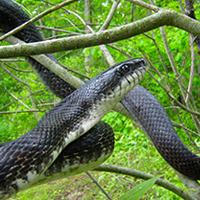Gray ratsnake
Scientific name: Pantherophis spiloides

Cover photo credit: Rob Tervo
Status
Endangered (Carolinian population)
“Endangered” means the species lives in the wild in Ontario but is facing imminent extinction or extirpation.
Threatened (Frontenac Axis population)
“Threatened” means the species lives in the wild in Ontario, is not endangered, but is likely to become endangered if steps are not taken to address factors threatening it.
Date added to the Species at Risk in Ontario List
The Gray ratsnake was already assessed when the Endangered Species Act took effect in 2008.
Read the most recent assessment reports:
What it looks like
The Gray Ratsnake, is also commonly known as the Black Ratsnake or the Eastern Ratsnake. It is non-venomous and is Ontario’s largest snake, reaching up to 2 metres in length.
This elegant snake has a shiny black body with a white chin and throat. The belly is white or yellowish with dark spots that often produce a checkerboard pattern. Young snakes are grey with dark blotching on the body and tail.
Where it lives
The two populations of Gray Ratsnake in Ontario can be found in different types of habitat.
The Frontenac Axis population requires a variety of habitat types including deciduous forests, wetlands, lakes, rocky outcrops and agricultural fields. The Carolinian population is found in a mix of agricultural land and deciduous forest, preferring habitat where forest meets more open environments.
Adults are strongly attached to their home ranges and often return to the same nesting and hibernation sites. They often lay eggs in logs or compost piles that serve as incubators. Sometimes several females will use the same site to deposit eggs.
Where it’s been found in Ontario
Gray Ratsnakes are widely distributed throughout the eastern and central United States, extending as far north as southern Ontario.
There are two widely separated populations in Ontario: the Carolinian in southwestern Ontario and the Frontenac Axis in southeastern Ontario.
What threatens it
The most significant threats to the Gray Ratsnake are the loss and fragmenting of habitat and persecution by people. Other serious threats include motor vehicles and the destruction of suitable hibernation sites.
Since ratsnakes hibernate in groups at the same site year after year, destroying these sites can have a large impact on the local population. The Gray Ratsnake is slow to mature and reproduce which may also inhibit recovery of this species.
Action we are taking
Endangered Species and their general habitat are automatically protected
Recovery strategy
A recovery strategy advises the ministry on ways to ensure healthy numbers of the species return to Ontario.
Read the executive summary (September 10, 2010)
Read the recovery strategy (September 10, 2010)
Government response statement
A government response statement outlines the actions the government intends to take or support to help recover the species.
Read the government response statement (June 15, 2011)
Five-Year Review of Progress
A five-year review reports on progress made toward protecting and recovering a species, within five years of publishing a species’ government response statement.
Read the report on progress towards the protection and recovery of 27 species at risk, including Gray Ratsnake (2016).
Habitat protection
A habitat regulation defines a species' habitat and many describe features (e.g., a creek, cliff, or beach), geographic boundaries or other unique characteristics.
Read the habitat summary for the Carolinian population (July 1, 2012)
Read the habitat summary for the Frontenac Axis population (July 1, 2012)
What you can do
Report a sighting
- Report a sighting of an endangered animal or plant to the Natural Heritage Information Centre. Photographs with specific locations or mapping coordinates are always helpful.
Volunteer
- Volunteer with your local nature club or provincial park to participate in surveys or stewardship work focused on species at risk.
Be a good steward
- Private land owners have a very important role to play in species recovery. If you find Gray ratsnake on your land, you may be eligible for stewardship programs that support the protection and recovery of species at risk and their habitats.
- Visit the Toronto Zoo Adopt-a-Pond website to learn more about Ontario’s rare snakes, their habitat and related conservation initiatives.
- Register with the Herpetofaunal Atlas program to receive e-mail newsletters, event notifications, and other important updates about the Herpetofaunal Atlas project as it develops. Visit their website to see how you can participate and learn more about Ontario’s reptiles and amphibians.
- Never buy snakes that have been caught in the wild and never buy a native species of any kind that’s being sold as a pet.
- Every year, snakes all over the province must cross busy roads. Watch for snakes on the roads, especially between May and October.
- Appreciate snakes and don’t harm them. Keep the danger of snakes in perspective: All of Ontario’s snakes are non-venomous, except for the very shy Massasauga Rattlesnake
Report illegal activity
- Report any illegal activity related to plants and wildlife to
1-877-TIP-SMNR (847-7667) .
Quick facts
- If two male ratsnakes are interested in the same female, the males will compete in physical combat for the right to mate.
- During the breeding season, females will mate with multiple males and produce a clutch of eggs sired by different fathers.
- This snake is an excellent climber. Watch for the Gray Ratsnake overhead, where it may be up a tree or bush sunning, preparing to shed its skin or hunting for prey.
- The Gray Ratsnake is a constrictor and feeds mostly on small mammals and birds. Since it spends some of its time in trees, it is an efficient predator of bird nests.